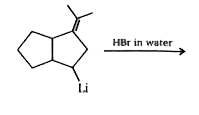In Which of the following reaction an acid-base reaction takes place ?



All of these
The correct Answer is:D
To determine which of the reactions involves an acid-base reaction, we can analyze each reaction step by step.
1. Understanding Grignard Reagents:
- Grignard reagents have the general formula R-MgX, where R is an alkyl or aryl group, and X is a halogen.
- They act as strong bases because they contain a carbon atom with a negative charge (R⁻), which can accept protons (H⁺).
2. Identifying Acid-Base Reactions:
- An acid-base reaction occurs when a proton (H⁺) is transferred from an acid to a base.
- In this context, R⁻ (from Grignard reagents) acts as a base, and any proton donor (like H⁺ from water or acids) acts as an acid.
3. Analyzing Each Reaction:
- Reaction A:
- Cyclohexane with CH₂MgCl reacts with water.
- CH₂⁻ (from CH₂MgCl) acts as a base and captures a proton (H⁺) from water, which is an acid.
- This is an acid-base reaction.
- Reaction B:
- An organolithium reagent (RLi) reacts with HBr in the presence of water.
- R⁻ (from RLi) can accept H⁺ from HBr or water, making it a base, while HBr acts as an acid.
- This is also an acid-base reaction.
- Reaction C:
- Another Grignard reagent reacts with a deuterated compound (D₂O).
- The carbon anion (C⁻) can capture a proton (D⁺) from D₂O, acting as a base, while D₂O acts as an acid.
- This is again an acid-base reaction.
4. Conclusion:
- All the reactions analyzed involve the transfer of protons, confirming that they are acid-base reactions.
- Therefore, the answer to the question is that all of these reactions are acid-base reactions.
Final Answer:
All of these reactions are acid-base reactions.
- Grignard reagents have the general formula R-MgX, where R is an alkyl or aryl group, and X is a halogen.
- They act as strong bases because they contain a carbon atom with a negative charge (R⁻), which can accept protons (H⁺).
- An acid-base reaction occurs when a proton (H⁺) is transferred from an acid to a base.
- In this context, R⁻ (from Grignard reagents) acts as a base, and any proton donor (like H⁺ from water or acids) acts as an acid.
- Reaction A:
- Cyclohexane with CH₂MgCl reacts with water.
- CH₂⁻ (from CH₂MgCl) acts as a base and captures a proton (H⁺) from water, which is an acid.
- This is an acid-base reaction.
- Reaction B:
- An organolithium reagent (RLi) reacts with HBr in the presence of water.
- R⁻ (from RLi) can accept H⁺ from HBr or water, making it a base, while HBr acts as an acid.
- This is also an acid-base reaction.
- Reaction C:
- Another Grignard reagent reacts with a deuterated compound (D₂O).
- The carbon anion (C⁻) can capture a proton (D⁺) from D₂O, acting as a base, while D₂O acts as an acid.
- This is again an acid-base reaction.
- All the reactions analyzed involve the transfer of protons, confirming that they are acid-base reactions.
- Therefore, the answer to the question is that all of these reactions are acid-base reactions.
All of these reactions are acid-base reactions.
Similar Questions
Knowledge Check
- Question 1 - Select One
Which of the following reactions takes place at anode ?
AReductionBOxidationCDecompositionDDissolution - Question 2 - Select One
Which of the following reactions does not take place?
AC2H5Br+KNO2→C2H5−O−N=O+KBrB CC2H5Br+AgCN→C2H5NC+AgBrDC2H5Br+KCN→C2H5NC+KBr
CC2H5Br+AgCN→C2H5NC+AgBrDC2H5Br+KCN→C2H5NC+KBr - Question 3 - Select One or More
Which of the following reactions take place by SN2 reaction?
A B
B C
C D
D
In which of the following reaction formation of reaction intermediate does not take place?
View SolutionWhich of the following reactions does not take place?
View SolutionWhich of the following reactions does not take place?
View SolutionWhich of the following reaction does not take place ?
View SolutionWhich of the following Diels− Alder reactions do not take place ?
View Solution

